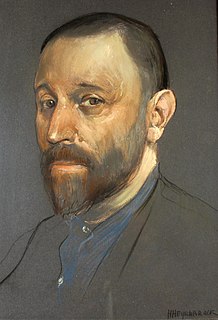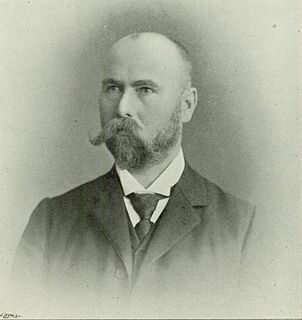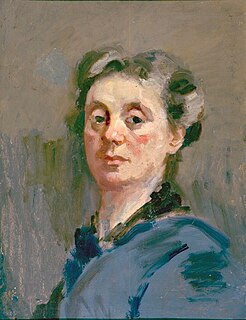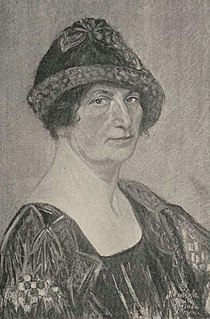
(passport photograph)
Salomon Garf (6 December 1879, Amsterdam – 27 August 1943, Auschwitz) was a Dutch painter and graphic artist; known for his portraits and still lifes. He was murdered in the Holocaust.

Salomon Garf (6 December 1879, Amsterdam – 27 August 1943, Auschwitz) was a Dutch painter and graphic artist; known for his portraits and still lifes. He was murdered in the Holocaust.
He was born to a family of diamond merchants and his father worked as a stockbroker. [1] Rather than follow in the family business, he chose a career in art, studying at the "Institute for Applied Arts" (1892–1895), the "State Normal School for Applied Arts" (1895–1899) and the Rijksakademie (1899–1905), where he worked with August Allebé and Nicolaas van der Waay. In 1904, he entered the Prix de Rome with his depiction of the Raising of the son of the woman of Shunem, but the prize went to Jan Sluijters. [1]
After graduating, he moved to the artists' colony in Laren and was married there two years later. In 1914, he won the Willink van Collenprijs for a painting of his studio. That same year, he and his family moved back to Amsterdam. In Laren, he had focused on painting rural interiors and still lifes. Once he had become established in Amsterdam, he mostly produced portraits and interior scenes with elegantly dressed women. His wife died in 1928, and he never remarried. [2] He was a member of Arti et Amicitiae and, in 1933, was awarded their golden medal on behalf of Queen Wilhelmina. [1] Garf's work was included in the 1939 exhibition and sale Onze Kunst van Heden (Our Art of Today) at the Rijksmuseum in Amsterdam. [3]
In 1938, he became a member of Arti's Board of Directors, but was expelled from the organization in 1941, by orders of the German occupation command. He then became active in the Resistance, helping to forge false "Persoonsbewijzen" (Identity Cards). [2] On August 6, 1943, he was arrested and sent to Auschwitz, by way of the Westerbork transit camp, and was murdered. His students managed to save the contents of his studio before they were confiscated. [1]

Samuel Jessurun de Mesquita was a Dutch graphic artist active in the years before the Second World War. His pupils included graphic artist M. C. Escher (1898–1972). A Sephardic Jew, in his old age he was sent to Auschwitz by the Nazis, where he was gassed along with his wife. After the war, de Mesquita was largely forgotten.

Dirk Johannes van Haaren was a Dutch painter.

Roelof Paul Citroen was a German-born Dutch artist, art educator and co-founder of the New Art Academy in Amsterdam. Among his best-known works are the photo-montage Metropolis and the 1949 Dutch postage stamps.

Herman Heijenbrock, was a Dutch writer, painter, pastel draughtsman, and lithographer. He founded the "Museum van den Arbeid" in 1923, which later became NEMO Science Museum.

Bernard de Hoog was a Dutch painter influenced by the Hague School.

Jacoba Johanna (Coba) Ritsema, was a portrait painter from the Netherlands.

Otto Boudewijn de Kat, was a Dutch painter and art critic.

Gerrit David Gratama, was a Dutch artist, writer, and director of the Frans Hals Museum.

Max van Dam was a Dutch artist born in Winterswijk. He was murdered in the Sobibor extermination camp.

Hobbe Smith was a Dutch painter, watercolorist and graphic designer, in the Post-Impressionist style.
Henriëtte Gesina Numans was a Dutch painter.

Ed Gerdes or Eduard Gerdes (1887–1945) was a Dutch painter, art teacher, member of honorary art selection committees and the last years of his life head of the Dutch Kultuurkamer.

Hermanus Ellen (Herman) Mees was a Dutch artist, active as painter, watercolorist, draftsman, pastelist, lithographer, and academy lecturer. He was specialized in portrait painting.

Jan Willem "Willy" Sluiter was a Dutch painter. He was best known for his paintings of Dutch villages and its dwellers, and also did portraits of members of Dutch high society. His work was part of the art competitions at four Olympic Games.
Felix Hess was a Dutch painter. He studied at Rijksakademie van beeldende kunsten in Amsterdam. His teachers included Pieter Dupont. He was a member of Arti et Amicitiae and Kunstenaarsvereniging Sint Lucas. His work was part of the painting event in the art competition at the 1928 Summer Olympics. His work was included in the 1939 exhibition and sale Onze Kunst van Heden at the Rijksmuseum in Amsterdam.

Marianne Franken was a Dutch painter.

Hendrika Van Gelder (1870-1943) was a Dutch painter known for portraits and still lifes.
Gerardina Anna Allegonda Martina Hooft (1894-1994) was a Dutch painter know for her still lifes.
Lucia Paulina Keijser (1875-1958) was a Dutch painter known for her floral still lifes.

Cornelia "Corrie" Johanna Pabst (1865-1943) was a Dutch artist.
| Wikimedia Commons has media related to Salomon Garf . |